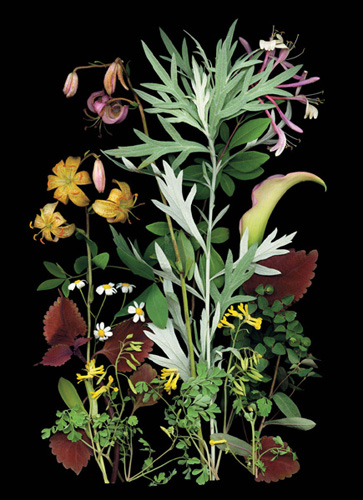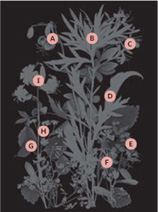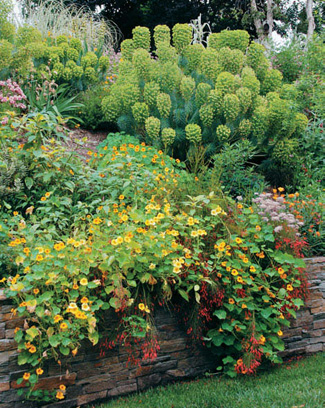
Among the risky or beneficial plants are: A Lilium martagon; B Artemisia ludoviciana ‘Silver King’*; C Lonicera periclymenum ‘Serotina Florida’; D Zantedeschia ‘Crystal Blush’; E Euphorbia dulcis ‘Chamaeleon’; F Corydalis lutea; G Solenostemon (syn. Coleus) scutellariodes; H Tanecetum parthenium; I Lilium ‘Mrs, R. O. Backhouse’.


One critter’s treasure is another’s toxin. Like fragrance, color, and other aspects of plants we find attractive, the essential oils that make many plants appealing to us for imparting fragrance to soap or perfume did not evolve for our benefit. These properties may be natural insect deterrents. Many of the most fragrant plants are from the Mediterranean region, where browsing animals scamper up the hot, dry hillsides sampling anything they come across. Pungent-tasting and strong-smelling plants like rosemary, thyme, and lavender have the best chance of being passed over. Aromatic or bitter qualities might also be more than unappetizing; they might be warnings of danger.
Whenever anyone writes about medicinal plants, there has to be a cautionary caveat. Do not eat anything you are not familiar with. Many of our best-loved garden plants can be harmful if ingested. Some members of the Fabaceae family are favorite edibles, like garden peas. Others, wisteria for instance, should not be consumed. Some plants may have harmful parts. Rhubarb is a good example: The stems are edible; the leaves are not.
Narcissus and hyacinths are poisonous, which is why deer rarely eat them (they love tulips, however). Oleander is toxic. Larkspur and monkshood can be sickening. Lily-of-the-valley is poisonous, as well. Some plants pose other problems. The herb rue (Ruta graveolens) tastes bitter, but it also may cause a skin rash. Rue is phototoxic and may produce blistering if touched in sunlight.
Eating too much of one plant could be lethal, while eating a little could be healthful. Some plants that are poisonous are also life-giving sources of medicines. It has been estimated that as many as one out of every six pharmaceuticals were originally derived from plants. A great example is foxglove (Digitalis parviflora): Too much of this plant will stop a person’s heart if eaten, but a little bit properly administered is an important cardiac drug.
Hippocrates (460–377 BCE), the father of medicine, left records of a powder made from the bark and leaves of the willow tree (Salix alba) to relieve headaches, pains, and fevers. In 1828, Johann Buchner, isolated a tiny amount of needle-like crystals, which he called salicin. A buffered version of the miracle drug, acetylsalicylic acid, was patented as Asprin in 1900 by the Bayer company.
Flowering nasturtium blossoms are edible; those of tall green euphorbia are not!
